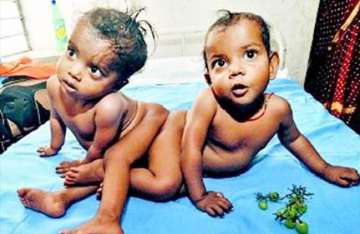A 12 to 15 hour complicated surgery is being planned by doctors at Batra Hospital, Delhi to separate the conjoined twins Seeta and Geeta, hailing from Bihar's East Champaran district. The father of the Subhash Mukhiya is a daily wage labourer.
Just over a year old, the conjoined twins are joined at the hip. They have common reproductive/genital organs and a urinary tract. Their lower intestinal opening is also common, reports Times of India.
Having arrived at the hospital around 4 pm on Monday evening, the two sisters were subjected to a series of tests — liver and kidney function, electrolyte, urine tests and X-rays of all their body parts.
The two sisters will undergo a DTPA renal scan to access the state of their kidneys, a spiral CT scan of their abdomens to check the condition of their intestines and MRIs of their hips and spine.
Speaking to TOI, Dr Sanjeev Bagai, CEO and senior paediatrician and nephrologist of Batra Hospital, said the surgery would be a highly precise and technically difficult one.
The team will have to create a urinary diversion, an intestinal diversion, and reconstruct the lower part of the pelvis and hip bones, keeping in mind no neurological damage occurs to any of the two kids.
‘‘The lower part of the twins' spines is joined externally. Neurosurgeons will have to ensure that when separating the two, neither suffers from any neurological deficits in their lower limbs postsurgery. We will have to separate the gut. In such children, there is a common passage for stool and a common urinary tract causing infection,” Dr Bagai said.
Dr Bagai, who will be assisted by Dr Arvind Sabbarwal (paediatric surgeon) and Dr Rohit Nayar (plastic surgeon) among others, added, ‘‘We will first recreate 3D images of all the organs and the surgical procedure on the computer 48 hours before the actual operation takes place. The twins are slightly malnourished. The date for surgery will be decided on Thursday.”
So how long will the surgery take? The team said it could be anywhere between 12-15 hours. Doctors will start from the external point of union of the hips. The approach is superficial and deep. Once hip area is free, surgeons will work simultaneously on the spine and the lower part of the urinary tract. ‘‘Gauging by the external appearance, I am optimistic that the surgery will be a success,” Dr Bagai said. The hospital plans to consult the globally renowned Prince of Wales Children's Hospital in Sydney if need be.
Conjoined twins are rare, occurring about once in every 200,000 births. The overall survival rate of conjoined twins is somewhere between 5% and 25%. Historical records over the past 500 years detail 600 surviving sets of conjoined twins.
Approximately 40% to 60% of conjoined twins arrive stillborn and about 35% survive only a day.
For some reason, female siblings seem to have a better survival rate than their male counterparts. Although more male twins conjoin in the womb than female twins, females are three times as likely as males to be born alive.
Approximately 70% of all conjoined twins are girls. Conjoined twins are genetically identical, and are, therefore, always the same sex. They develop from the same fertilised egg.
Latest India News
